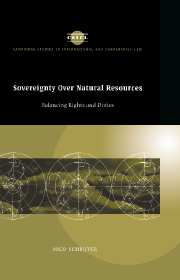Book contents
- Frontmatter
- Contents
- List of boxes, figures and tables
- Preface
- Acknowledgments
- List of abbreviations
- List of main symbols used in UN documents
- Glossary
- Table of cases
- 1 Introduction
- PART I The birth and development of the principle: the UN General Assembly as midwife
- PART II Natural-resource law in practice: from creeping national jurisdiction towards international co-operation
- Introductory remarks to Part II
- 6 International investment law: from nationalism to pragmatism
- 7 The law of the sea: extension of control over marine resources
- 8 International environmental law: sovereignty versus the environment?
- PART III Balancing rights and duties in an increasingly interdependent world
- Appendices
- Bibliography
- Index
- Books in the series
7 - The law of the sea: extension of control over marine resources
Published online by Cambridge University Press: 23 October 2009
- Frontmatter
- Contents
- List of boxes, figures and tables
- Preface
- Acknowledgments
- List of abbreviations
- List of main symbols used in UN documents
- Glossary
- Table of cases
- 1 Introduction
- PART I The birth and development of the principle: the UN General Assembly as midwife
- PART II Natural-resource law in practice: from creeping national jurisdiction towards international co-operation
- Introductory remarks to Part II
- 6 International investment law: from nationalism to pragmatism
- 7 The law of the sea: extension of control over marine resources
- 8 International environmental law: sovereignty versus the environment?
- PART III Balancing rights and duties in an increasingly interdependent world
- Appendices
- Bibliography
- Index
- Books in the series
Summary
‘Planet Ocean’
Two-thirds of the surface area of our planet consists of seas and oceans. For centuries the main principle governing the uses of these areas was freedom of the seas, under which everyone could navigate, conduct commerce and fish, as long as the rights of others to do so were not hindered. Sovereignty was only recognized for a narrow belt of sea along the coast: more or less three miles, as far as one could see or fire with a cannon from ashore. During the twentieth century this situation has changed drastically, as evidenced by the 1982 UN Convention on the Law of the Sea in which territorial sovereignty over adjacent maritime areas has been substantially extended. Permanent sovereignty over natural resources as applied to the seas has found recognition in the form of extensive continental shelves and 200-mile exclusive economic zones. The rush of coastal States to claim more of the sea was halted by what remains of the principle of the freedom of the high seas, as well as by the introduction of a new principle applicable to the deep sea-bed and its resources: the common heritage of mankind. Criteria for the delimitation of the maritime zones are far from clear and potential conflicts as a result of competing claims are numerous which underscores the relevance of the elaborate scheme for international dispute settlement under the 1982 Convention.
- Type
- Chapter
- Information
- Sovereignty over Natural ResourcesBalancing Rights and Duties, pp. 202 - 230Publisher: Cambridge University PressPrint publication year: 1997

